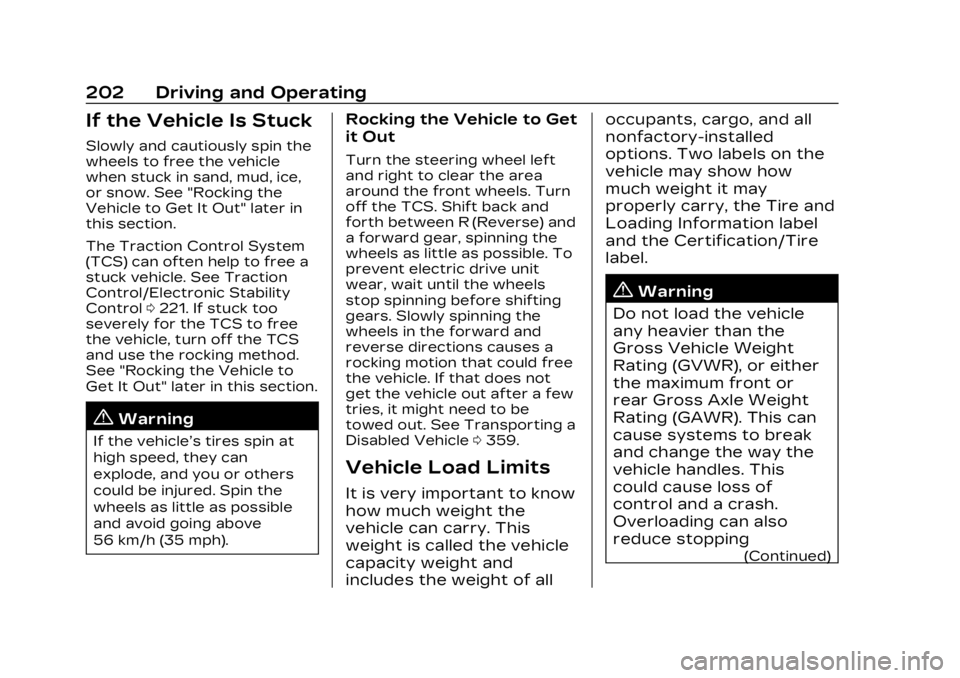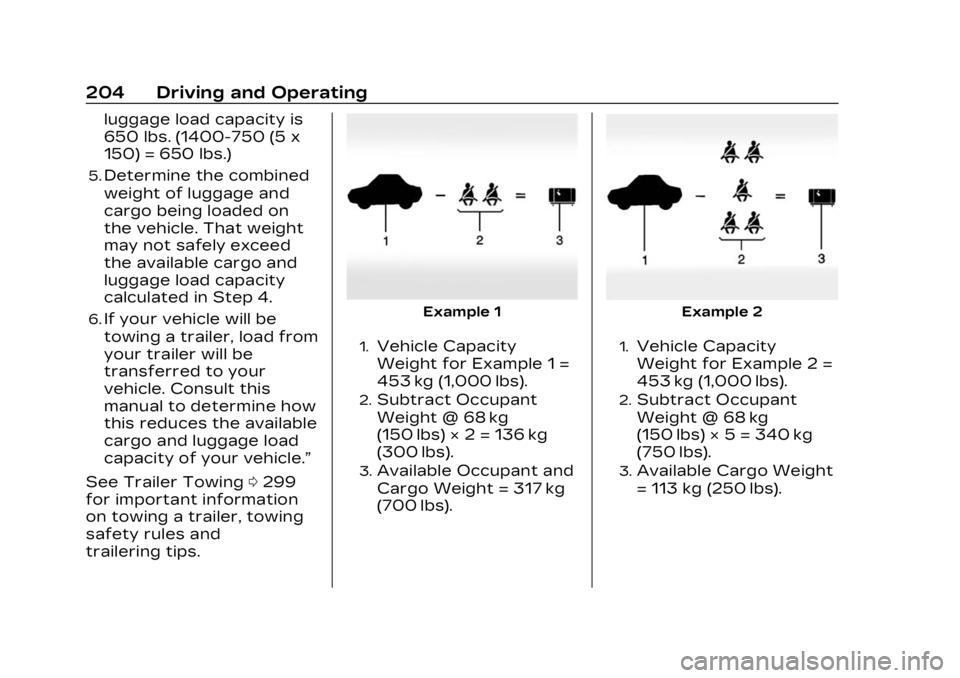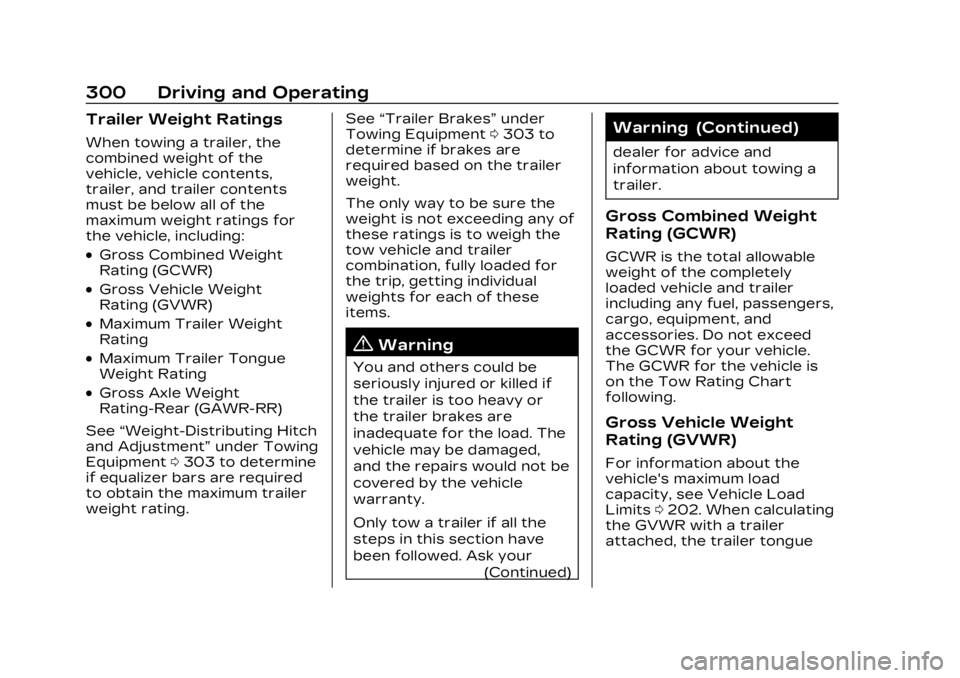2023 CADILLAC LYRIC load capacity
[x] Cancel search: load capacityPage 203 of 424

Cadillac Lyriq Owner Manual (GMNA-Localizing-U.S./Canada-15644413) -
2023 - CRC - 2/23/22
202 Driving and Operating
If the Vehicle Is Stuck
Slowly and cautiously spin the
wheels to free the vehicle
when stuck in sand, mud, ice,
or snow. See "Rocking the
Vehicle to Get It Out" later in
this section.
The Traction Control System
(TCS) can often help to free a
stuck vehicle. See Traction
Control/Electronic Stability
Control0221. If stuck too
severely for the TCS to free
the vehicle, turn off the TCS
and use the rocking method.
See "Rocking the Vehicle to
Get It Out" later in this section.
{Warning
If the vehicle’s tires spin at
high speed, they can
explode, and you or others
could be injured. Spin the
wheels as little as possible
and avoid going above
56 km/h (35 mph).
Rocking the Vehicle to Get
it Out
Turn the steering wheel left
and right to clear the area
around the front wheels. Turn
off the TCS. Shift back and
forth between R (Reverse) and
a forward gear, spinning the
wheels as little as possible. To
prevent electric drive unit
wear, wait until the wheels
stop spinning before shifting
gears. Slowly spinning the
wheels in the forward and
reverse directions causes a
rocking motion that could free
the vehicle. If that does not
get the vehicle out after a few
tries, it might need to be
towed out. See Transporting a
Disabled Vehicle 0359.
Vehicle Load Limits
It is very important to know
how much weight the
vehicle can carry. This
weight is called the vehicle
capacity weight and
includes the weight of all occupants, cargo, and all
nonfactory-installed
options. Two labels on the
vehicle may show how
much weight it may
properly carry, the Tire and
Loading Information label
and the Certification/Tire
label.
{Warning
Do not load the vehicle
any heavier than the
Gross Vehicle Weight
Rating (GVWR), or either
the maximum front or
rear Gross Axle Weight
Rating (GAWR). This can
cause systems to break
and change the way the
vehicle handles. This
could cause loss of
control and a crash.
Overloading can also
reduce stopping
(Continued)
Page 204 of 424

Cadillac Lyriq Owner Manual (GMNA-Localizing-U.S./Canada-15644413) -
2023 - CRC - 2/23/22
Driving and Operating 203
Warning (Continued)
performance, damage the
tires, and shorten the life
of the vehicle.
Tire and Loading Information
Label
Example Label
A vehicle-specific Tire and
Loading Information label is
attached to the center
pillar (B-pillar). The tire and
loading information label
shows the number of
occupant seatingpositions (1), and the
maximum vehicle capacity
weight (2) in kilograms and
pounds.
The Tire and Loading
Information label also
shows the size of the
original equipment tires (3)
and the recommended cold
tire inflation pressures (4).
For more information on
tires and inflation see Tires
0
334 and
Tire Pressure 0342.
There is also important
loading information on the
vehicle Certification/Tire
label. It may show the
Gross Vehicle Weight
Rating (GVWR) and the
Gross Axle Weight Rating
(GAWR) for the front and
rear axle. See
“Certification/Tire Label”
later in this section.
“Steps for Determining
Correct Load Limit– 1.
Locate the statement
"The combined weight of
occupants and cargo
should never exceed
XXX kg or XXX lbs." on
your vehicle’s placard.
2.Determine the combined
weight of the driver and
passengers that will be
riding in your vehicle.
3.Subtract the combined
weight of the driver and
passengers from XXX kg
or XXX lbs.
4.The resulting figure
equals the available
amount of cargo and
luggage load capacity.
For example, if the "XXX"
amount equals 1400 lbs.
and there will be five
150 lb passengers in your
vehicle, the amount of
available cargo and
Page 205 of 424

Cadillac Lyriq Owner Manual (GMNA-Localizing-U.S./Canada-15644413) -
2023 - CRC - 2/23/22
204 Driving and Operating
luggage load capacity is
650 lbs. (1400-750 (5 x
150) = 650 lbs.)
5.Determine the combined
weight of luggage and
cargo being loaded on
the vehicle. That weight
may not safely exceed
the available cargo and
luggage load capacity
calculated in Step 4.
6.If your vehicle will be
towing a trailer, load from
your trailer will be
transferred to your
vehicle. Consult this
manual to determine how
this reduces the available
cargo and luggage load
capacity of your vehicle.”
See Trailer Towing 0299
for important information
on towing a trailer, towing
safety rules and
trailering tips.Example 1
1.Vehicle Capacity
Weight for Example 1 =
453 kg (1,000 lbs).
2.Subtract Occupant
Weight @ 68 kg
(150 lbs) × 2 = 136 kg
(300 lbs).
3.Available Occupant and
Cargo Weight = 317 kg
(700 lbs).
Example 2
1.Vehicle Capacity
Weight for Example 2 =
453 kg (1,000 lbs).
2.Subtract Occupant
Weight @ 68 kg
(150 lbs) × 5 = 340 kg
(750 lbs).
3.Available Cargo Weight
= 113 kg (250 lbs).
Page 206 of 424

Cadillac Lyriq Owner Manual (GMNA-Localizing-U.S./Canada-15644413) -
2023 - CRC - 2/23/22
Driving and Operating 205
Example 3
1.Vehicle Capacity
Weight for Example 3 =
453 kg (1,000 lbs).
2.Subtract Occupant
Weight @ 91 kg
(200 lbs) × 5 = 453 kg
(1,000 lbs).
3.Available Cargo Weight
= 0 kg (0 lbs).
Refer to the vehicle's tire
and loading information
label for specific
information about the
vehicle's capacity weight and seating positions. The
combined weight of the
driver, passengers, and
cargo should never exceed
the vehicle's capacity
weight.
Certification/Tire Label
Label Example
A vehicle-specific
Certification/Tire label is
attached to the center
pillar (B-pillar).
The label may show the
size of the vehicle's original
tires and the inflationpressures needed to obtain
the gross weight capacity
of the vehicle. The label
shows the gross weight
capacity of the vehicle. This
is called the Gross Vehicle
Weight Rating (GVWR). The
GVWR includes the weight
of the vehicle, all
occupants, and cargo.
The Certification/Tire label
may also show the
maximum weights for the
front and rear axles, called
the Gross Axle Weight
Rating (GAWR). To find out
the actual loads on the
front and rear axles, weigh
the vehicle at a weigh
station. Your dealer can
help with this. Be sure to
spread the load equally on
both sides of the
centerline.
Page 301 of 424

Cadillac Lyriq Owner Manual (GMNA-Localizing-U.S./Canada-15644413) -
2023 - CRC - 2/23/22
300 Driving and Operating
Trailer Weight Ratings
When towing a trailer, the
combined weight of the
vehicle, vehicle contents,
trailer, and trailer contents
must be below all of the
maximum weight ratings for
the vehicle, including:
.Gross Combined Weight
Rating (GCWR)
.Gross Vehicle Weight
Rating (GVWR)
.Maximum Trailer Weight
Rating
.Maximum Trailer Tongue
Weight Rating
.Gross Axle Weight
Rating-Rear (GAWR-RR)
See “Weight-Distributing Hitch
and Adjustment” under Towing
Equipment 0303 to determine
if equalizer bars are required
to obtain the maximum trailer
weight rating. See
“Trailer Brakes” under
Towing Equipment 0303 to
determine if brakes are
required based on the trailer
weight.
The only way to be sure the
weight is not exceeding any of
these ratings is to weigh the
tow vehicle and trailer
combination, fully loaded for
the trip, getting individual
weights for each of these
items.
{Warning
You and others could be
seriously injured or killed if
the trailer is too heavy or
the trailer brakes are
inadequate for the load. The
vehicle may be damaged,
and the repairs would not be
covered by the vehicle
warranty.
Only tow a trailer if all the
steps in this section have
been followed. Ask your
(Continued)
Warning (Continued)
dealer for advice and
information about towing a
trailer.
Gross Combined Weight
Rating (GCWR)
GCWR is the total allowable
weight of the completely
loaded vehicle and trailer
including any fuel, passengers,
cargo, equipment, and
accessories. Do not exceed
the GCWR for your vehicle.
The GCWR for the vehicle is
on the Tow Rating Chart
following.
Gross Vehicle Weight
Rating (GVWR)
For information about the
vehicle's maximum load
capacity, see Vehicle Load
Limits0202. When calculating
the GVWR with a trailer
attached, the trailer tongue
Page 340 of 424

Cadillac Lyriq Owner Manual (GMNA-Localizing-U.S./Canada-15644413) -
2023 - CRC - 2/23/22
Vehicle Care 339
(2) Tire Width:The 3-digit
number indicates the tire
section width in millimeters
from sidewall to sidewall.
(3) Aspect Ratio
:A 2-digit
number that indicates the
tire height-to-width
measurements. For
example, if the tire size
aspect ratio is 75, as
shown in item (3) of the
illustration, it would mean
that the tire's sidewall is
75 percent as high as it
is wide.
(4) Construction Code
:A
letter code is used to
indicate the type of ply
construction in the tire. The
letter "R" means radial ply
construction; the letter "D"
means diagonal or bias ply
construction.
(5) Rim Diameter
:
Diameter of the wheel in
inches. (6) Service Description
:
These characters
represent the load index
and speed rating of the
tire. The load index
represents the load
carrying capacity a tire is
certified to carry. The
speed rating is the
maximum speed a tire is
certified to carry a load.
Tire Terminology and
Definitions
Air Pressure:The amount
of air inside the tire
pressing outward on each
square inch of the tire. Air
pressure is expressed
in kPa (kilopascal) or psi
(pounds per square inch).
Aspect Ratio
:The
relationship of a tire's
height to its width. Belt
:A rubber coated layer
of cords that is located
between the plies and the
tread. Cords may be made
from steel or other
reinforcing materials.
Bead
:The tire bead
contains steel wires
wrapped by steel cords
that hold the tire onto
the rim.
Bias Ply Tire
:A pneumatic
tire in which the plies are
laid at alternate angles less
than 90 degrees to the
centerline of the tread.
Cold Tire Pressure
:The
amount of air pressure in a
tire, measured in kPa
(kilopascal) or psi (pounds
per square inch) before a
tire has built up heat from
driving. See Tire Pressure
0 342.
Page 341 of 424

Cadillac Lyriq Owner Manual (GMNA-Localizing-U.S./Canada-15644413) -
2023 - CRC - 2/23/22
340 Vehicle Care
DOT Markings:A code
molded into the sidewall of
a tire signifying that the
tire is in compliance with
the U.S. Department of
Transportation (DOT)
Motor Vehicle Safety
Standards. The DOT code
includes the Tire
Identification Number (TIN),
an alphanumeric designator
which can also identify the
tire manufacturer,
production plant, brand,
and date of production.
GVWR
:Gross Vehicle
Weight Rating. See Vehicle
Load Limits 0202.
GAWR FRT
:Gross Axle
Weight Rating for the front
axle. See Vehicle Load
Limits 0202.
GAWR RR
:Gross Axle
Weight Rating for the rear
axle. See Vehicle Load
Limits 0202. Intended Outboard
Sidewall
:The side of an
asymmetrical tire, that
must always face outward
when mounted on a vehicle.
Kilopascal (kPa)
:The
metric unit for air pressure.
Light Truck (LT-Metric)
Tire
:A tire used on light
duty trucks and some
multipurpose passenger
vehicles.
Load Index
:An assigned
number ranging from 1 to
279 that corresponds to
the load carrying capacity
of a tire.
Maximum Inflation
Pressure
:The maximum
air pressure to which a cold
tire can be inflated. The
maximum air pressure is
molded onto the sidewall. Maximum Load Rating
:
The load rating for a tire at
the maximum permissible
inflation pressure for
that tire.
Occupant Distribution
:
Designated seating
positions.
Outward Facing Sidewall
:
The side of an
asymmetrical tire that has
a particular side that faces
outward when mounted on
a vehicle. The side of the
tire that contains a
whitewall, bears white
lettering, or bears
manufacturer, brand, and/
or model name molding
that is higher or deeper
than the same moldings on
the other sidewall of
the tire.
Page 342 of 424

Cadillac Lyriq Owner Manual (GMNA-Localizing-U.S./Canada-15644413) -
2023 - CRC - 2/23/22
Vehicle Care 341
Passenger (P-Metric)
Tire
:A tire used on
passenger cars and some
light duty trucks and
multipurpose vehicles.
Recommended Inflation
Pressure
:Vehicle
manufacturer's
recommended tire inflation
pressure as shown on the
tire placard. See Tire
Pressure 0342 and
Vehicle Load Limits 0202.
Radial Ply Tire
:A
pneumatic tire in which the
ply cords that extend to
the beads are laid at
90 degrees to the
centerline of the tread.
Rim
:A metal support for a
tire and upon which the tire
beads are seated.
Sidewall
:The portion of a
tire between the tread and
the bead. Speed Rating
:An
alphanumeric code
assigned to a tire indicating
the maximum speed at
which a tire can operate.
Traction
:The friction
between the tire and the
road surface. The amount
of grip provided.
Tread
:The portion of a
tire that comes into
contact with the road.
Treadwear Indicators
:
Narrow bands, sometimes
called wear bars, that show
across the tread of a tire
when only 1.6 mm (1/16 in)
of tread remains. See
When It Is Time for New
Tires 0349.
UTQGS (Uniform Tire
Quality Grading
Standards)
:A tire
information system that
provides consumers with
ratings for a tire's traction, temperature, and
treadwear. Ratings are
determined by tire
manufacturers using
government testing
procedures. The ratings
are molded into the
sidewall of the tire. See
Uniform Tire Quality
Grading
0352.
Vehicle Capacity Weight
:
The number of designated
seating positions multiplied
by 68 kg (150 lbs) plus the
rated cargo load. See
Vehicle Load Limits 0202.
Vehicle Maximum Load on
the Tire
:Load on an
individual tire due to curb
weight, accessory weight,
occupant weight, and cargo
weight.
Vehicle Placard
:A label
permanently attached to a
vehicle showing the
vehicle's capacity weight